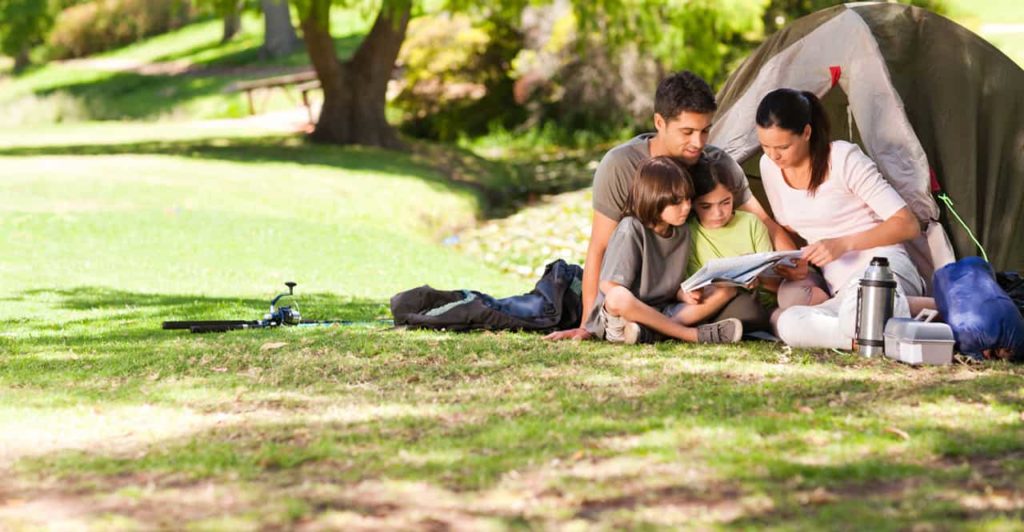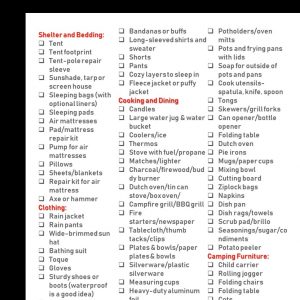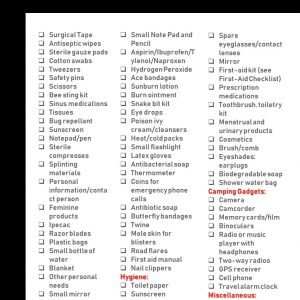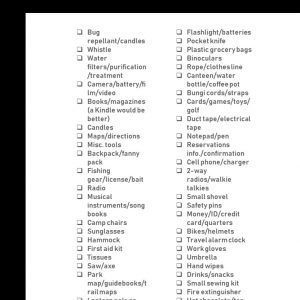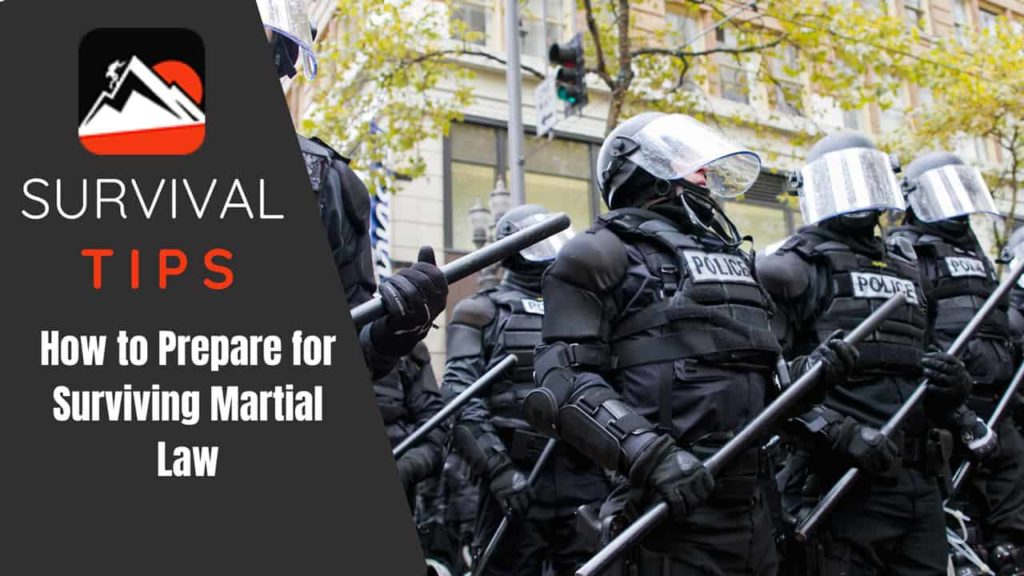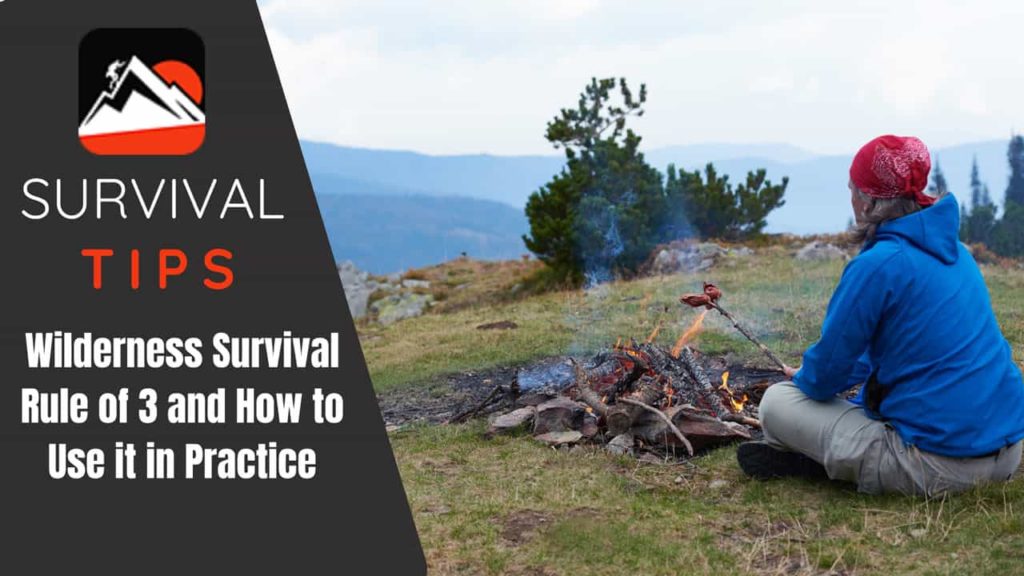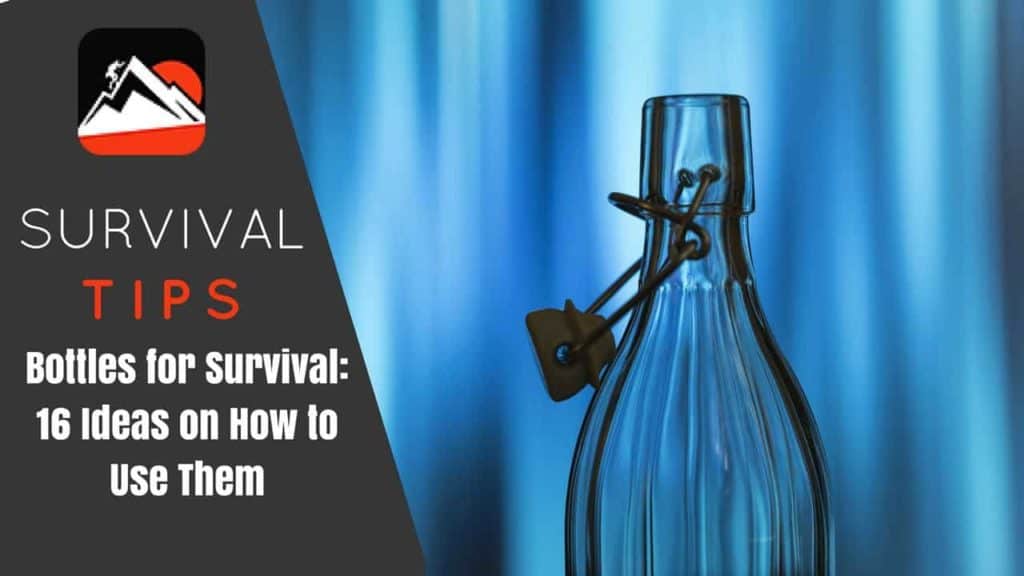Contents
Camping is arguably one of the oldest and most reliable things that a family can do together which can actually satisfy all members of the family. However, for every great camping trip, there are dozens more mired in inconvenience and happenstance. Of course, this is rarely random and most of the time there are numerous decisions and preparations you can make to better ensure that you have the best camping experience you can. That is why we put together this guide, so you can make sure your camping trip is a success before you ever hit the road.
>>>>> PRINTABLE CAMPING CHECKLIST <<<<<
Click on each one of the images to see the printable version of each one of them.
TIPS FOR PLANNING A GREAT CAMPING TRIP

Despite how difficult and chaotic it may seem to plan a family camping trip, there are actually a couple of ways to break the task down and areas of focus that will make it that much easier. Keep in mind, this extends well beyond making sure you bring everything that you need–pretty much everyone remembers that one and often overestimate in that regard as well. Instead, the best types of preparation involve understanding the region you are going to and what to expect as well as do once you get there.
If you are going camping in the mountains, then make sure to research what type of hiking trails and vistas they have in the region. If you are going to an area with access to clean, running fresh water, do not be afraid to go a little overboard. So long as find clever ways to save on space and weight, you will always seem to manage to find a place for that last fun thing you want to bring along–funny how that works.
On the flip side, the other element of familiarity that you will want involves protecting yourself from potential risks. For instance, you likely know to avoid bears, wolves, or other large predators on your own without any need to actually plan ahead beyond identifying their known hotspots. Likewise, you will probably avoid a snake or a spider, whether or not it is venomous, simply because there is no real reason to test those waters–unless, of course, you are either a heterophile or Arachnophilia.
That said, you may not necessarily be able to pick out plants that are poisonous to touch or consume simply by looking at them. There are also liable to be subtle dangers in the landscape in general that might not be made readily apparent without first doing a little research. Things like sinkholes or other types of instability in the ground should be avoided, but first, they need to be known.
Other considerations regarding the area’s risks can also include atmospheric and will depend heavily on the biome. For instance, you will likely want to prepare for fairly different weather if you are camping in Florida than in you go camping in Arizona–even though both places are hot weather climates. While some of this can be covered with gear, which we will address later, it is important to actually understand the risks and how to address them–why the given response is the right response.
This is because all of your preparations may ultimately be for naught under the worst of circumstances, and you still need to be able to respond intelligently to inclement circumstances. The shiniest new gadget can get dropped in a river or on a rock or down a ravine or have any number of things happen to it, and you would still need to address whatever situation it was intended to resolve. In this regard, we would actually recommend some light survival instruction–at least for either some fundamental tasks or those specific to your setting.
That said, randomness and the unknown can also serve as great sources of entertainment, and a camping trip may be able to develop spontaneously by virtue of the setting and the moment collectively seizing the group–but you should not count on it. Conversely, neither should you feel the need to rigidly stick to a script when the world offers you a golden opportunity. As such, one of the best rules for plans is to think of yourself as the captain of a ship who must navigate with a rudder. You do not move the family, you simply give them a direction and let them go following wherever the current goes.
You might also find interesting our article about tips to keep in mind when lost in the wild.
10 CAMPING ACTIVITIES FOR A FUN FAMILY CAMPING EXPERIENCE

When planning camping activities, the most important to remember is to pick an activity that everyone can do. This will basically whittle your options down based on competence and comprehension where the activity must be something all participants understand as well as be able to physically perform. This can actually get a bit tricky for families with larger gaps in age between the members.
1. HIKING
There is arguably no better “go-to” camping activity than hiking since it requires no real equipment and can be done in virtually every biome. On top of that, hiking is simple enough that even a toddler can figure it out, so it provides entertainment for every age group. That said, hiking is unlikely to keep energetic young boys entertained without some other type of activity or goal to accompany the hike. As such, hiking is actually a great transitional activity and can be turned into its own adventure on the way to an adventure if you plan properly and are camping in the right location. If at all possible, try to avoid hikes through heavily wooded areas as this is more likely to inspire boredom and wandering than a trail with impressive vistas.
2. SWIMMING
Another family favorite primarily because it is ultimately an inexpensive form of entertainment that is once again appropriate for all age groups, swimming is arguably a better activity than camping for most purposes, but it is not always going to be an option for all settings. That said, the sheer ease that swimming can provide a camping trip in terms of entertainment means you should likely look for a place that has a body of water. If you live in an arid region, do not be afraid to drive out of state for the right location since it will be the memories you cherish–not the principles of where you camped.
3. CAMPFIRE
This is another activity that is pretty much a classic and almost an expectation at this point again in a large part because it is something that everyone can do. Granted, you will need to be more careful with this activity, but whether it is roasting hotdogs and marshmallows or telling ghost stories, campfires are an ancient and almost instinctual thing that seems to inspire conversation and social interaction. This is an even better activity if you are camping in a region that gets a little chilly at night as the fire will provide both warmth as well as a focal point.
4. NATURE WATCHING
Okay, so this is likely not the best activity for those with young boys, but for a fair number of families, nature watching can provide a wonderfully enriching and entertaining experience. Whether you choose birds, flowers, or any other type of living thing, this can present both the task of finding the particular category of thing as well as an opportunity to learn and apply the knowledge practically. Just make sure you do your research ahead of time, so you know what to look for.
5. FISHING
To be fair, this may be considered a gendered activity, but so long as everyone is willing to try, fishing can be a great family activity. Granted, the dad may very well have to spend most of his time with the other fishers and not necessarily get to enjoy as much fishing himself, but the enjoyment everyone has–not to mention the potential to generate a new interest–make this a solid option for those with access to running water.
6. GAMES
This one will technically not require any preparatory effort on your part as your children are liable to play games on their own whether you join in or not. That said, games like, capture the flag, or hide and seek are great camping activities as they offer a unique setting without the worry of breaking anything. As such, kids will often go all out when playing these kinds of games while camping.
7. SPORTS
This can be a great camping activity, but it will heavily depend on your family whether or not this is a good choice–and chances are you already know whether or not it is. If your children are athletically inclined, sports serve just as good a purpose keeping them entertained while simultaneously expending their energy so they will be easier to get to sleep. Just do not see this as an opportunity to try and force an interest that is not there.
8. CARDS AND BOARD GAMES
This should not be seen as a first choice when it comes to camping, but all too often circumstances can force plans to change. If it rains for one or more days that you are camping, it helps to have some form of indoor activity to keep you entertained. Board games and cards can actually be a great way to pass the time while driving to and from the campsite too. Just pick something with a few small pieces as possible.
9. WATER CRAFTS
This activity is obviously similar to swimming, except that you also have the option of simply riding around on the watercraft if you prefer. On top of that, you can also fish from boats–even if they are simply a small rowboats. The issue is that watercrafts require a larger body of water and will also often be located in a more populated area or a popular campsite. As such, it may not be an option depending on the type of camping experience you want to have.
10. STARGAZING
Once the sun goes down, the number of options at your disposal soon dwindles as the relative safety of the day turns riskier at night. Thankfully, you can lie on your back and look up at the stars to keep you entertained–just make sure to pick a spot away from urban light pollution for the best views. Even better, you can use this as an opportunity to teach your children as well if you study a bit ahead of time.
HOW TO SET UP YOUR CAMP THE RIGHT WAY

The most important step to setting up your camp is picking your campsite as this will ultimately influence all of your other decisions. Ideally, you will want to find a campsite that is at or near the highest elevation point in the nearby area. This will help ensure that any rain is unlikely to flood you out of your campsite with all of the water running downhill instead.
One consideration that will depend on your shelter is whether or not you should set up camp in a clearing. For most people who have self-standing tents, a larger clearing that is flat with a soft bed of grass is the ideal spot for a campsite. Of course, if your tents are not self-supporting, then you may very well need to camp near a copse of trees if not on the edge of a wooded area. Regardless, make sure that the ground is as flat as possible and that you have either the space or support that your camping shelter requires.
One thing you will want to do early once you have figured out where you will be setting up camp is to designate where to use the restroom. Regardless of the type of restroom you choose to make, as is detailed later in the article, getting it set up early is a good way to ensure that no one accidentally contaminates the campsite. Also, always remember to position the restroom downhill from the campsite to further prevent contamination.
If you have more than one tent, then you will want to layout the collapsed tent where they will go and create a bit of a blueprint for the campsite which will ensure that everything has the space it needs. Remember, most tents will require anywhere from one to three feet of clearance on all sides to make room for the guylines. As such, you will likely want to give them another 2’ of clearance to prevent people from tripping and falling–especially at night. You will also want to make sure that the campfire is far enough away from the tents that sparks cannot jump to them.
In terms of the arrangement, try to set up your camp so that the breakdown will be as quick and easy as possible. Aside from the fact that this will make repacking everything that much easier, it will also position you well in case you need to leave immediately–for instance, if there is some freak blizzard or tropical storm that was not predicted bearing down on you. This will also make going to and from your vehicle–something you will likely do quite often to protect certain items–less inconvenient.
Finally, it is a good idea to make sure that your camp is set up in such a way that it can be broken down sustainably. This means making sure that you keep trash receptacles in a clearly designated area and that all wastes are properly covered once you leave. On top of that, it is a good idea to construct any ready-made things like the campfire, restroom, and anything else–like a tent foundation–so that they can be easily collapsed or deconstructed without disrupting more of the nearby ecosystem.
ESSENTIAL ITEMS TO PACK
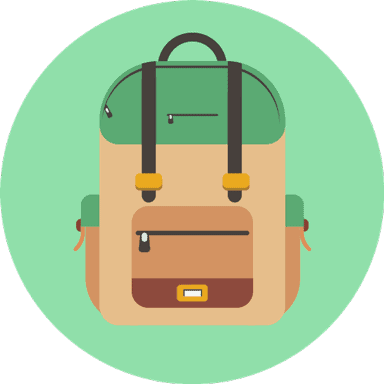
In terms of “essential items,” we consider this to be either: essential gear that is not already covered on this list or, more commonly, gear that can serve numerous purposes. In this case, most of these items are basic survival gear, and though they may not be used in exactly the same way, they will still likely get plenty of solid use. A good example of this is the survival knife.
The survival knife is arguably the most important piece of gear to have in an outdoor survival situation, but it does not lose any of its usefulness or versatility just because you are not teetering on the precipice of survival. As such, you will want to make sure that not only do you have a high-quality survival knife but that you have a backup just in case–it is that important. Other types of gear and equipment which are exceedingly valuable in a survival situation continue to shine through in a more casual, camping scenario.
For instance, you can pretty much never have too much paracord, because the moment you think you have enough, you will find another use for it that will make you wish you had just a little bit more. In fact, doing a little research can show you the wealth of things you can do with paracord alone which not only offers an incredibly useful piece of equipment but even a possible activity and teachable moment if you plan properly. A vinyl tarp is fairly similar in this way as it too can be used for dozens of legitimately valuable purposes while camping.
In terms of gear that will be covered, just make sure you have contingencies for the most likely type of inclement weather you are liable to face. If you are camping in Alaska, then make sure you bring cold-weather gear. Likewise, those camping in the Pacific Northwest would do well to make sure that they can wait out the rain without getting soaked in the process. Regardless, weather-dependent gear is definitely essential–especially for family camping trips where not all members may be able to handle the same intensity of conditions.
One item you may want to consider, though it can be a bit contentious, is self-defense. Whenever you go out into the wilds, there is always a chance that you could run across a wild animal. While in most situations this will simply resolve with the animal fleeing, there are circumstances that may cause the animal to become hostile. In this instance, it is a good idea to have some kind of self-defense to ward off injured, territorial, or otherwise aggressive animals.
You do not need to require lethal self-defense, by the way, as pepper sprays and other forms of non-lethal deterrents are often effective. That said, if you are camping in a region with known large predators, it might be a good idea to make sure you have all of your bases covered. Just remember to practice the same kind of care and responsibility with any firearm while camping that you would at home.
SHELTER AND BEDDING
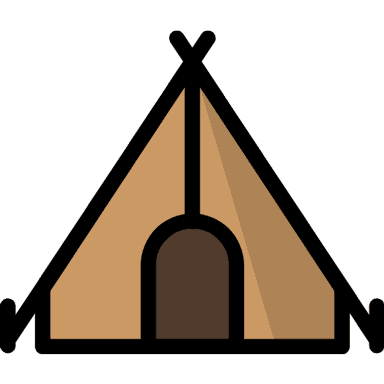
When it comes to shelter and bedding, this will depend on what type of experience you are looking to have as glamping can offer comfort and convenience, but there is a certain pride one can get from “roughing it.” Regardless of how easy you want to take this on yourself, your decision will carry significant consequences either way. Remember, no activity or amount of things to do will make a camping trip more enjoyable if it hurts to turn your neck.
As such, one of the most important things to keep in mind when selecting your shelter and bedding is the space and support provided. In this case, you will not want to scrunch up with everyone in a single tent as this will likely cause discomfort and prevent you from being as refreshed as possible. Unless you purchase a tent that is designed to house the same number of full-sized adults as you bring people, you are going to want to opt for more than one tent.
Similarly, with bedding, the inclusion of an air mattress or other bedding is not necessary so long as you can ensure that your neck and back are properly supported. Pallets on the ground are a common and effective foundation for your bedding and can be prepared fairly quickly and easily with few or no tools. However, it is far more important to make sure that your joints are supported when you sleep than anything else.
Think of it similarly to the princess and the pea where a seemingly minor difference can actually have significant consequences later down the line. Of course, if you are glamping, then you likely do not need to worry about any of this with your electric camper and spring mattress. That said, regardless of how you are camping always bring extra bedding as water can quickly soak bedding before you even know it.
- Tent
- Tent footprint
- Tent-pole repair sleeve
- Sunshade, tarp or screen house
- Sleeping bags (with optional liners)
- Sleeping pads
- Air mattresses
- Pad/mattress repair kit
- Pump for air mattresses
- Pillows
- Sheets/blankets
- Repair kit for air mattress
- Axe or hammer
CLOTHING

When it comes to packing clothing for a camping trip, the margins for error can be a bit smaller than expected. That said, unless you have plenty of extra room, then you are probably going to want to pack just as much clothing as you need and no more to make sure you have room for all of the other equipment and gear. This means figuring out how many clothes you actually need and then only packing that amount.
For instance, it is a fairly common refrain these days that people have a tendency to pack an absurd number of pairs of underwear. Humorous though it may be, this actually presents a problem as those pairs of underwear are now occupying space that could otherwise be filled with something that the group will actually get some use out of. Of course, this is not to suggest that there is no wisdom to be had in packing a few extra pairs of underwear and other articles of clothing–simply there is no need to go overboard and a real consequence for doing so.
Arguably the most important thing to consider when packing clothes for a camping trip is keeping the type of biome in mind while you pack. Remember, if you drive an hour to the foot of a mountain range, then there is a pretty good chance that the weather will be different in that region. As such, you will want to make sure that you remember to pack your clothing for the place you are going to, not necessarily the place you are when you pack.
- Rain jacket
- Rain pants
- Wide-brimmed sun hat
- Bathing suit
- Toque
- Gloves
- Sturdy shoes or boots (waterproof is a good idea)
- Sandals
- Socks
- Underwear
- Sports bra
- Short-sleeved shirts
- Sun-shielding hats
- Swimsuits
- Bandanas or buffs
- Long-sleeved shirts and sweater
- Shorts
- Pants
- Cozy layers to sleep in
- Fleece jacket or puffy jacket
COOKING AND DINING

It may take a little bit more preparation and a smidgen more labor, but that can also be the difference between a great meal cooked out in the field or something you get through to sate your hunger. Of course, if you are willing to put in a bit more effort, you can actually construct a fairly solid fire pit over which you can cook a wide variety of foods–including most vegetables. As such, there really is little to no reason that you and your family should not enjoy the same level of quality food that you eat in the comfort of your own home.
That said, it is far more important to cook to your skill level than it is to follow some checklist or try to impress your fellow campers. As such, if a Coleman camping burner is the best way for you to cook food while camping, do not attempt to force the issue–especially not at the moment. If you are truly interested, take the time to learn how to properly cook over an open fire before risking the evening’s dinner.
Arguably more important than how to cook the food is what to do once you are done as the smell of food can attract wild animals. Makes sure to clean any non-disposable cutlery and dishware and clean up all of your trash placing it away from your camp as to not attract animals. Finally, you will want to make sure that any open flames are completely snuffed, doused, and cool to the touch.
- Large water jug & water bucket
- Coolers/ice
- Thermos
- Stove with fuel/propane
- Matches/lighter
- Charcoal/firewood/buddy burner
- Dutch oven/tin can stove/box oven/
- Campfire grill/BBQ grill
- Fire starters/newspaper
- Tablecloth/thumb tacks/clips
- Plates & bowls/paper plates & bowls
- Silverware/plastic silverware
- Measuring cups
- Heavy-duty aluminum foil
- Paper towels
- Trash bags
- Dish soap
- Clothes pins
- Cooking oil/Pam spray
- Containers for food storage
- Potholders/oven mitts
- Pots and frying pans with lids
- Soap for outside of pots and pans
- Cook utensils-spatula, knife, spoon
- Tongs
- Skewers/grill forks
- Can opener/bottle opener
- Folding table
- Dutch oven
- Pie irons
- Mugs/paper cups
- Mixing bowl
- Cutting board
- Ziplock bags
- Napkins
- Dish pan
- Dish rags/towels
- Scrub pad/brillo
- Seasonings/sugar/condiments
- Potato peeler
CAMPING FURNITURE

Outside of survivalists, there are few campers–even more naturalistic enthusiasts–who are willing to ignore the benefits of solid camping furniture. It is important to remember that camping furniture serves an incredibly important purpose beyond simply providing you a more comfortable seat: it gets you off of the ground. This may not seem like a big deal, but it can make a huge difference depending on your circumstances.
For instance, if you are camping in a region that is infested with numerous types of insects and other vermin, you will definitely appreciate the bulk of your body is located a foot or two off of the ground. That said, there are always potential unexpected turns of events which can make the use of camping furniture more of a need than a want, and that is the weather.
Specifically, rain can make a camping trip miserable, but that experience will only get worse if you have to always stay in a tent or camper. Even with the rain, proper camping furniture can allow you to take a canopy and make a fairly usable space–assuming that it does not storm too intensely.
That said, you will want to make sure that you include some form of a collapsible table to go along with collapsible chairs for every member. Plastic, aluminum, magnesium, polyester, and nylon are all materials to look for as they provide the best mix of cost, durability, and portability–the last of which is arguably more important than the other qualities unless you and your family are avid campers.
- Child carrier
- Rolling jogger
- Folding chairs
- Folding table
- Cots
FIRST AID KIT
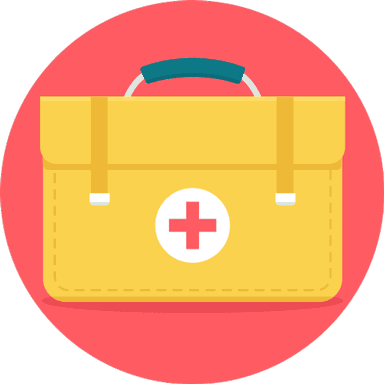
Assuming you take care of the other steps on this checklist, there is a good chance that you will not need to use a first aid kit due to planning. That said, there is always the chance that an accident will bring up the need for a first aid kit. Of course, there are also plenty of general items which you will want to include, though those may or may not necessarily be considered true “first aid,” like bug repellent.
Still, there are plenty of potential situations which you are far more liable to encounter out camping than you would in your everyday life as well as plenty which may occur regardless of where you are. A good example of this, especially for those of you who have young, energetic children, is antibacterial ointment to place over cuts or most open wounds to help prevent infection and foster a quick recovery. A topical disinfectant like iodine or rubbing alcohol is always a good idea as these items can not only serve for first aid purposes but can often be adapted to other uses while camping as well.
Another item that you should likely keep on hand in general, not just when you go out camping, is some type of analgesic–whether that is an anti-inflammatory, like ibuprofen, or aspirin, it is likely more important that you have something of the sort while camping than at home where the distraction of pain presents less risk. Due to the emerging data on acetaminophen, or Tylenol, we cannot recommend that product at this time except perhaps in the “baby” dosage.
Do not feel the need to go overboard with the dressings as anything which is serious enough to require significant dressing is significant enough to end the camping trip over. In fact, it should be understood that the first aid kit is meant to provide relief for minor symptoms or ailments and should not in any way be meant to serve as a substitute for professional medical care–even if the injury does not “seem that bad.”
- Basic First Aid Kit
- Personal medications
- Roll bandages
- Adhesive tape
- Antiseptic wipes
- Sterile gauze pads
- Cotton swabs
- Tweezers
- Safety pins
- Scissors
- Bee sting kit
- Sinus medications
- Tissues
- Bug repellant
- Sunscreen
- Notepad/pen
- Sterile compresses
- Splinting materials
- Personal information/contact person
- Feminine products
- Ipecac
- Razor blades
- Plastic bags
- Small bottle of water
- Blanket
- Other personal needs
- Small mirror
- Triangular bandages
- Misc. Band-Aides/bandages
- Anti-acids (Tums, Rolaids)
- Antibiotic cream
- Aspirin/Ibuprofen/Tylenol/Naproxen
- Hydrogen Peroxide
- Ace bandages
- Sunburn lotion
- Burn ointment
- Snake bit kit
- Eye drops
- Poison ivy cream/cleansers
- Heat/cold packs
- Small flashlight
- Latex gloves
- Antibacterial soap
- Thermometer
- Coins for emergency phone calls
- Antibiotic soap
- Butterfly bandages
- Twine
- Mole skin for blisters
- Road flares
- First aid manual
- Nail clippers
HYGIENE
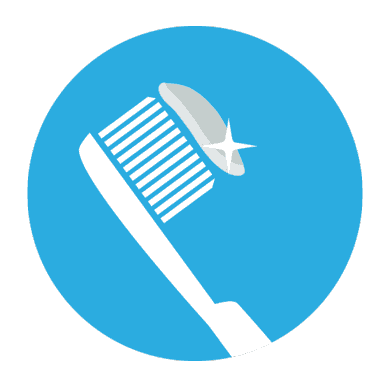
Though being outdoors may provide a sense of freedom and a desire to go “au naturale,” it is important to remember that good hygiene does not simply serve to make being in close proximity to one another more pleasant, instead of serving a far more important role in the general health and well-being of the individual. This is especially important for parents who may have children who are already questionable in terms of hygiene as a complete collapse of already inconsistent habits can actually carry significant risks.
This is likely never truer than when it comes to bathing, though there are actually plenty of workarounds for this regardless of your setting or biome. If you are camping near some form of clean, moving water, then this task becomes much easier–though it is important to remember not to actually bathe yourself in the water directly as this can contaminate the water. Still, for those without access to clean, rushing water there are always dry shower products that can provide a hygienic if less than the ideal, solution.
The risks of not bathing while camping are significantly higher and potentially more consequential than those you would encounter in an urban setting. Because the biome is likely teeming with diversity, various types of fungus and other microorganisms are far more likely to be prevalent. As such, if you do not practice good hygiene, you will place yourself more at risk to contract something. Again, this is far more of a concern for children who are more likely to go traipsing through brush or other such areas reckless and unprotected.
- Sunscreen
- Lip balm
- Insect repellent
- Hand sanitizer
- Alcohol or antiseptic wipes
- Spare eyeglasses/contact lenses
- Mirror
- First-aid kit (see First-Aid Checklist)
- Prescription medications
- Toothbrush, toiletry kit
- Menstrual and urinary products
- Cosmetics
- Brush/comb
- Eyeshades; earplugs
- Biodegradable soap
- Shower water bag
CAMPING GADGETS

While some die-hard enthusiasts will consider the use of any tool or equipment which uses an electric charge to be “cheating,” there are still plenty of gadgets that you can bring which will make so many other things that much easier. You do not have to give in to the temptation of “glamping” to improve your lot a great deal with minor additions. For instance, the generation of power is arguably more important than any individual device itself.
This is especially true in regards to smart devices which are often ostensibly considered “emergency devices” though in truth they are far more likely to be used to pass the time. Regardless the reasoning or actualization, it is still a good idea to make sure you can power your smart devices should a real emergency occur, and one of the best ways to do so is to get a high-quality, portable solar panel charger. The top-end models are actually sensitive enough to provide a modest charge even in overcast settings–which is liable to be when you need to charge a smart device for an emergency most.
Other “gadgets” that are the most useful and will improve your experience the most are often things that you may not think about. For instance, if you can find a top-tier multi-tool with a blade that can also serve as a survival knife, you can conceivably shed tons of gear–though you will likely still want to pack a few redundancies. However much space is saved on necessary gear can then be put to use for games and other items of entertainment or leisure.
- Camera
- Camcorder
- Memory cards/film
- Binoculars
- Radio or music player with headphones
- Two-way radios
- GPS receiver
- Cell phone
- Travel alarm clock
MISCELLANEOUS

Because this is a bit more of a delicate matter but all euphemisms aside, using the restroom while camping can be quite an affair–especially if you are “roughing it.” Though the reasons you may be thinking are surely one side of the coin, the other is that you need to do so responsibly in order to both protect the environment as well as not draw unwanted attention to yourself by the local wildlife.
As such, we will go through the proper way to set up a makeshift restroom using a couple methods:
Latrine – This is likely one of the first ideas that come to mind when considering outdoor restrooms, but it should be noted that latrines are generally meant to be used for extended periods of time. As such, if you are simply camping for the weekend, there is no need to go through this level of effort. That said, a latrine is a long furrow or trench dug into the ground that generally extends at least a few feet. The user will hover over the latrine while using the restroom and this does arguably make for the easiest method in practice.
Cathole – This is a more common method for smaller parties and those camping for a short time–a few days at the most. This is essentially a deep, though the somewhat narrow hole that it is little more than an outhouse without all of the dressing. This is quicker and easier to make than the latrine, but it can present a more challenging use if you do not plan the cathole out properly before using it.
- Sunscreen/chapstick
- Lantern with fuel/mantles
- Extra batteries/bulbs
- Compass/GPS
- Bug repellant/candles
- Whistle
- Water filters/purification/treatment
- Camera/battery/film/video
- Books/magazines (a Kindle would be better)
- Candles
- Maps/directions
- Misc. tools
- Backpack/fanny pack
- Fishing gear/license/bait
- Radio
- Musical instruments/song books
- Camp chairs
- Sunglasses
- Hammock
- First aid kit
- Tissues
- Saw/axe
- Park map/guidebooks/trail maps
- Lantern pole or hanger
- Collapsible drying rack
- Popcorn
- Marshmallows, Graham crackers,
- Hershey bars (Smores)
- Flashlight/batteries
- Pocket knife
- Plastic grocery bags
- Binoculars
- Rope/clothes line
- Canteen/water bottle/coffee pot
- Bungi cords/straps
- Cards/games/toys/golf
- Notepad/pen
- Reservations info./confirmation
- Cell phone/charger
- 2-way radios/walkie talkies
- Small shovel
- Safety pins
- Money/ID/credit card/quarters
- Bikes/helmets
- Travel alarm clock
- Work gloves
- Umbrella
- Hand wipes
- Drinks/snacks
- Small sewing kit
- Fire extinguisher
- Hot chocolate/tea bags/coffee
- Scissors
- Watch
HOW TO PREPARE YOUR VEHICLE FOR YOUR CAMPING TRIP

Much like you want to make sure that you are acutely aware of the circumstances surrounding the region you will be visiting, you will similarly want to make sure that your vehicle is prepared for the journey as well. Keep in mind, this could potentially make renting a vehicle for the camping trip a good idea depending on your starting circumstances. If your family uses one or more sedans, it might not be a bad idea to rent a larger SUV-size vehicle for the additional room.
That said, it is far more important to make sure that your vehicle has all of its various fluids and other regular maintenance checkup is freshly completed. The last thing that should happen is you get halfway to your camping location only to discover that your vehicle does not have a spare tire. As such, it is not a bad idea to actually take your vehicle to a professional before venturing out on your trip to make sure that everything is in good shape. Of course, this is actually fairly general, standard stuff you should do no matter what.
One thing you likely do not have to do is worry about cleaning the vehicle unless it is already in desperate need of attention. This is because there is a near certainty that whatever you do to clean the vehicle ahead of time will be undone by the time that you leave. This goes for both the exterior as well as the interior and it is not at all out of the question for you to be finding errant pine needles and other such detritus in various nooks and crannies months later–even if you thought you completely cleaned it.
As such, one thing you can do that will make things much easier is to try and find some system that will mitigate the dirt and other debris that enters the vehicle from the outside. Taking off shoes before getting inside and having some way to isolate them is a great way to prevent daily dirt, grass, and other mess from being tracked into your vehicle. There are also various products you can purchase that aim to provide some temporary surface area in the backseat of a vehicle to catch any crumbs or mess while eating.
The only thing that you might want to do for the vehicle in terms of its loadout is to make sure that it is either rated for the type of driving you will need to do or then augmented to do so. For instance, if you plan to camp near the foot of some mountains, you will want to make sure the vehicle can handle the route. Depending on how far away the location is, this can make doing a dry run a bit difficult in which case you should identify what aftermarket addition if any, will legitimately improve performance. Another example of this would be tires which will have an easier time driving in low gear over soft or wet terrain.
SAFETY TIPS FOR YOUR CAMPING ENJOYMENT

While the openness and unpredictability of nature can present some risks that you are not likely to encounter elsewhere, there are plenty of precautions that you can take to help mitigate them. For instance, it is important to make sure that you never leave any kind of food out in the open, and this extends well beyond what some might consider “food.” A good example of this would be a used paper plate with a dried film of ketchup as surely few people would consider that food. To a wild animal, however, that dried ketchup is full of sugars which will provide them a solid energy boost.
As such, if anything pretty much came in contact with food or foodstuffs, you will want to make sure that it is either contained in with an air-tight seal or that it is disposed of far away from your camp. Keep in mind, this can require some additional care beyond what may be expected as grabbing a car door handle with greasy hands after eating barbecue can inspire courageous scavengers to opt for the inanimate object over the sleeping people. The point is, food and, maybe, more importantly, its smells are one of the bigger dangers–though this is mostly due to negligence or ignorance.
Other safety tips that are important will likely depend more on the region than anything else as a number of safety tips are simply general guidelines. However, the most relevant safety tips for your needs will hinge on the types of risks you are expected to face. Making sure that you drink plenty of water is always important, but it is easily more important for those who are camping in a hot, arid climate. On the other hand, most people are not worried about the volume of their voice shifting whole mountainsides of snow.
Many of the best safety tips will inherently come from your camping plan that we discussed at the beginning of the article. Based on the information you learned about the specific area’s risks in terms of foundation, flora, and fauna, as well as the climate and biome, you should not only know what particular risks are unique to your region and have a plan for it. That said, there is one safety tip that is a bit more camping-centric that we have covered already but deserves a mention in every applicable opportunity: take care of your fires.
This is arguably more meaningful now when wildfires will regularly ravage countrysides for months on end and cause upwards of billions upon billions of dollars of damage. The fact that fires can actually be significantly easier to start than they are to put out contributes to this still being an issue, but the fact that even missing out on a, seemingly, the minor step can lead to a cinder sparking a flame. Beyond the greater risk, even a fire that does not rage out of control can still upend your camping trip and cause you personally considerable damage–not to mention the risk to loved ones and livelihood.
CONCLUSION
As we can see, a great deal of the finer details will depend heavily on where you go camping as the biome is going to have an outsized influence on the type of gear you need and types of plans you need–both for things to do and things to watch out for. Still, there are plenty of tips and tricks that apply broadly to camping in general, and with this guide, you should be more than well on your way to effectively navigate them. With these tools at your disposal, you should be more than capable of preparing and pulling off a memorable family camping trip.

